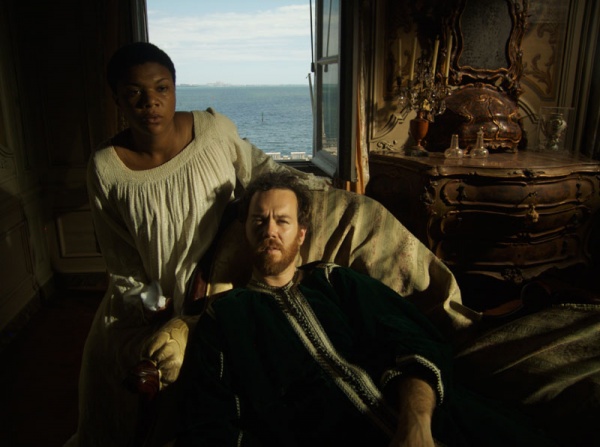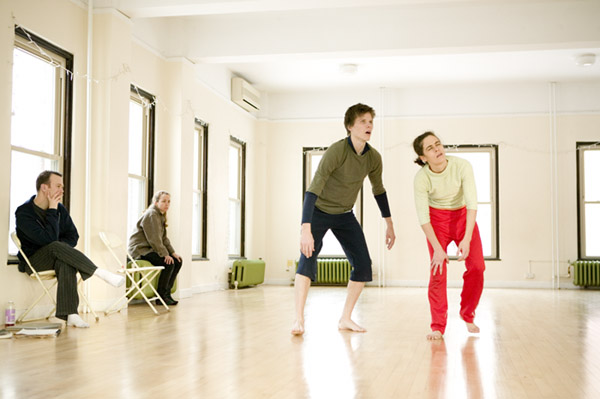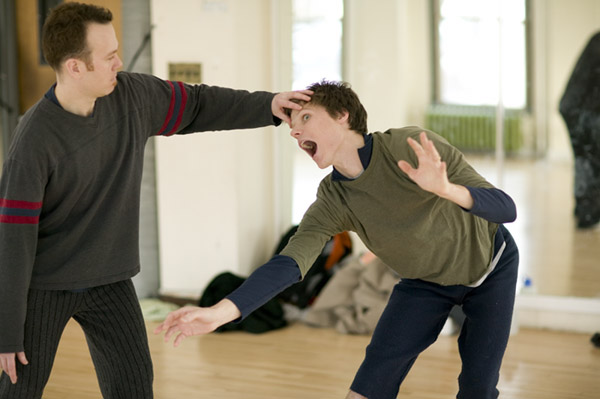 When artist Catherine Sullivan approached choreographer Dylan Skybrook about collaborating on a film project, details were deliberately scant. “ Catherine was almost comically stingy with information,” he told exhibition curator Doryun Chong. “ She told me: Neanderthals, Vizcaya [Museum and Gardens in Miami, Florida], Nigerian email scams, and that’s it. No context. She said the dancers are the Neanderthal layer and set me free.” Skybrook set out, assisted by local dancers Justin Jones and Kristin van Loon, to create movements inspired by the now-extinct cohabitants of humans’ ancient ancestors. The result of their exploration is on view in Triangle of Need, a multichannel film installation now making its world premiere at the Walker August 23.
When artist Catherine Sullivan approached choreographer Dylan Skybrook about collaborating on a film project, details were deliberately scant. “ Catherine was almost comically stingy with information,” he told exhibition curator Doryun Chong. “ She told me: Neanderthals, Vizcaya [Museum and Gardens in Miami, Florida], Nigerian email scams, and that’s it. No context. She said the dancers are the Neanderthal layer and set me free.” Skybrook set out, assisted by local dancers Justin Jones and Kristin van Loon, to create movements inspired by the now-extinct cohabitants of humans’ ancient ancestors. The result of their exploration is on view in Triangle of Need, a multichannel film installation now making its world premiere at the Walker August 23.
This most recent and ambitious project by the Chicago-based artist topically addresses class and evolution, among other things, and draws inspirations from a variety of images and ideas. Chong recently discussed the process of collaborating with Sullivan in a wide-ranging interview with Skybrook.
Doryun Chong: In your mind, what is Triangle of Need about?
Dylan Skybrook: I haven’t actually seen the film yet and so I can speak about the process but not about the final product. There are many different layers to the piece. There is the actual physical space and beauty of Vizcaya as well as the massive concentration of wealth it represents, there is the idea of Neanderthals and their seeming “disfigurement” relative to modern humans, there is the Nigerian layer as perhaps a representative of the global poor, and there are other layers as well. Each of these layers flowers in to other ideas and images. The intersections of which create mysterious outcomes that communicate something interesting and which is beyond what we might have imagined.
To me this piece is the images that it presents. It reminds me of the British theatre company Forced Entertainment. They insist that nothing onstage can mean anything else but what it is. So if there is a woman in a gorilla suit, crying – that’s all that that means, the gorilla suit doesn’t stand in for something. It just is the image that it is, irreducible by concepts.
DC: How did the idea of developing choreography based on the Neanderthal come to be? What is your take on it and its significance?
DS: Composer Sean Griffin, another collaborator on Triangle of Need, had been working on a Neanderthal “ language,” based on what paleobiologists have discovered and hypothesized about the size and shape of a Neanderthal voice box. Catherine integrated the idea into Triangle of Need and presented it to me having already thought about it quite a bit. She really liked the image of Neanderthals as a dead end, an extinct species of hominid. Soon after I agreed to do the project I saw a short piece at the Louvre by Brazilian filmmaker Sonia Andrade in which she winds a thread around her face, disfiguring it into sections. This struck me as similar in feeling to the Neanderthal, whose head seems like a disfigured version of a modern human, with its sloping forehead, huge eyebrow ridge, and protruding face. And when one reads the history of the science of Neanderthals it is clear that this seeming disfigurement has been fascinating and repelling people for 150 years. This impression became a source image that I tried to constantly evoke in the choreography, not only a physical disfigurement but also the accompanying feeling of a different kind of consciousness as well.
DC: What did developing the idea entail? What kind of research did you do and how did you interpret it into the body/facial movements?
DS: I did a lot of research. I studied the science regarding Neanderthals and I watched every “ caveman” movie I could find. I studied the morphology, shape and size of their bodies, how their skeletons were put together, the culture known from their tools and campsites. I also studied the history of the science as it has unfolded over the past 150 years. The early fossils of Neanderthals, which were the first archaic hominids found, were found at roughly the same time that Charles Darwin first published On the Origin of Species, and people really didn’t want to accept the idea that humans could have ever been in any form other than the one we’re in right now.
Once I had compiled the research, I came up with different activities I wanted us to do as Neanderthals. Simultaneously, Catherine sent me some lists of actions that she was interested in. We worked with improvisation to find our way into material that felt right. I leaned on Justin and Kristin a lot in this process. I made them improvise for ages while I tweaked small details. At some point I felt that we looked too much like modern dancers. I thought we needed another layer of activity. I was reminded of an actor who said that he imagined rolling a teacup all over his body as he was performing. This kind of distraction–amplified and made obvious–seemed appropriate for what we were up to. We began to add distractions, such as imagining our eyes rolling around the outside of our heads, to all of the material. These distractions created a feeling of character for us, a psychological state that we could tap into.
DC: what was the shoot like? You talked about Catherine’s working method and mind being kind of like a 3-D grid, where various vectors freely and unexpectedly converge and intersect.
DS: The shoot was actually thrilling. The images we were working with were beautiful, the other actors were amazing, the set was incredible, and we were working very fast. As you’ll see in the film Catherine had composed these beautiful, complex, long, seven or eight minute shots in which several different sites of action are discovered by the camera. The main images of each shot were already planned out but Catherine created a lot of background layers of action at the spur of the moment. She was amazing in her ability to remember and compose with my material. I couldn’t even remember off the top of my head all the sections we had made the way she could. I had to consult the list!
Catherine’s way of working was very interesting in that the preparation of the material, the costumes, the set, etc. was very rigorous. This allowed her to have all this material out in front of her and to be relatively free in how these different elements interacted. It was as if these elements were on a three-dimensional grid and how they interacted was an alchemical process the results of which could not be known until afterwards. The way in which she trusted this process was very impressive.
DC: What was most challenging and most rewarding about the process?
DS: Catherine was almost comically stingy with information in the beginning part of the process. She told me: Neanderthals, Vizcaya [the Florida mansion], Nigerian e-mail scams, and that’s it. No context. She said the dancers are the “ Neanderthal layer” and set me free. This caused me anxiety. However it was very rewarding to just keep moving forward without knowing what was going on. It interrupted my usual way of working and I found that valuable. Also, I trusted Catherine and that helped a lot. The shoot itself was very rewarding in that Kristin, Justin, and I were able to see how our work was combining with the work Catherine and Sean had created, and we were able to feel the entirety of the images altogether. We had been working in Minneapolis, separated from the actors who were based in Chicago. So to see each shot with our material, the actors, the costumes, all in such a beautiful setting as Vizcaya , was revelatory. There were all these moments in which one of us, overwhelmed by the beauty unfolding, would turn to the other two and say, “ I love my job.”
DC: how do you view this collaboration with Catherine in relation to your work in general?
DS: The material I created for Triangle of Need is very different from the work I usually make. As a choreographer I’m usually concerned with composition in space and with movement quality. In this case I knew that I was not going to be able to see the space until the shoot and that therefore the work had to be somewhat modular, able to fit anywhere. Likewise, the movement quality had to evoke this feeling of disfigurement rather than my own contemporary style preferences. A lot of what I made was small, contained, emotional state-based improvisational scores. There are movement-phrases too but even these are often modified by a state. Often the scores and phrases were mixed and matched to come up with hybrid material.
Triangle of Need is essentially a theatre piece, the movement had to serve as evocation of the Neanderthal characters, which is very different from the work I usually make which is purely abstract. It opened up all kinds of avenues I normally don’t tend to travel down which was very enjoyable.
Get Walker Reader in your inbox. Sign up to receive first word about our original videos, commissioned essays, curatorial perspectives, and artist interviews.

